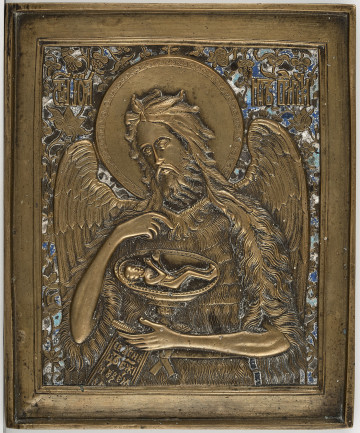
St. John the Baptist
20th century
Castle Museum in Łańcut
Part of the collection: Icons
The great martyr Antipas, listed by Christian writers as one of the 72 disciples of Christ and a disciple of John the Evangelist, was the bishop of Pergamon. Located near the present-day Turkish city of Bergama in Asia Minor, ancient Pergamon was a powerful centre of pagan cults. Antipas, who persistently proclaimed faith in Christ in Pergamon, was sacrificed by pagans in the temple of Artemis. The heroism and death of Antipas were evoked by John the Apostle in the Book of Revelation: "And to the angel of the church in Pergamum write: The One who has the sharp two-edged sword says this: ‘I know where you dwell, where Satan's throne is; and you hold fast My name, and did not deny My faith even in the days of Antipas, My witness, My faithful one, who was killed among you, where Satan dwells." (Revelation 2:12-13) The saint was martyred by being confined in a cast copper or bronze bull under which a fire was lit. This type of punishment was supposedly first used in Sicily by the cruel tyrant Phalaris in the 6th c. BCE. A temple was built above Antipas's grave in the 5th c. It became a site of miraculous healings. In prayer, the intercession of Antipas is believed to be especially effective for toothache, and he himself is considered the patron saint of stomatologists. Perhaps this is why depictions of the martyr Antipas dressed in the vestments of a bishop were very popular as icons of domestic and personal use, as can be seen on the displayed exhibit cast in an Old Believer workshop. The Old Believers, not recognising the liturgical reform of the Patriarch Nikon, which was in effect in the Moscow Orthodox Church since the middle of the 17th c., used their own icons exclusively, not recognising the depictions made in the official Orthodox Church. The day of St. Antipas was decreed to be the 24th of April (April 11 in the Julian calendar). Teresa Bagińska-Żurawska https://orcid.org/0000-0002-9243-3967
Dimensions
height: 5.7 cm, width: 5 cm
Object type
Icons
Technique
cast
Material
brass
Origin / acquisition method
decyzja administracyjna
Creation time / dating
Creation / finding place
Owner
Castle Museum in Łańcut
Identification number
Location / status

20th century
Castle Museum in Łańcut

19th (?) century
Castle Museum in Łańcut

1800 — 1850
Castle Museum in Łańcut
DISCOVER this TOPIC
Castle Museum in Łańcut
DISCOVER this PATH
Educational path